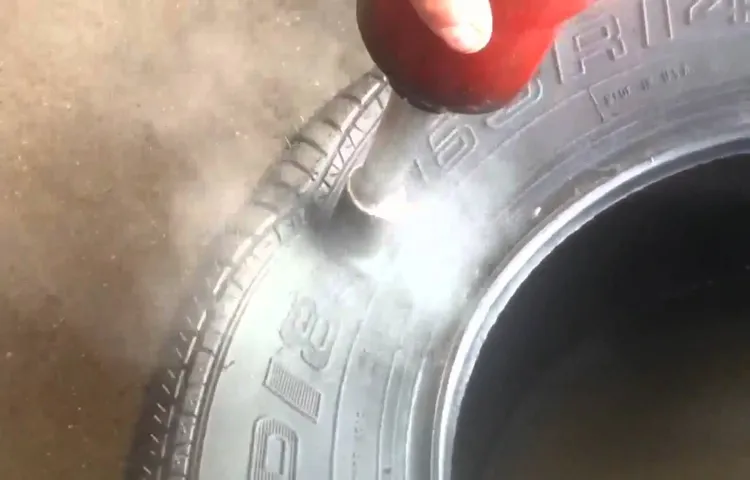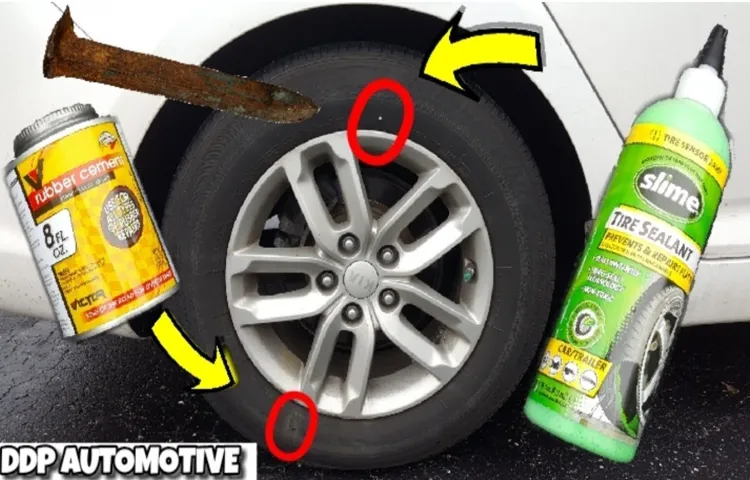Do you have a small hole in your tire that needs fixing? We’ve all been there – you’re driving down the road, minding your own business, when suddenly you hear a loud hissing sound. You pull over to the side of the road and find that you have a small hole in your tire. It can be frustrating, especially if you have places that you need to be.
But don’t worry, fixing a small hole in your tire is easier than you might think. Whether it’s a slow leak that’s been bothering you for weeks, or a sudden blowout that caught you off guard, fixing a small hole in your tire is an important skill to have. Not only can it save you time and hassle, but it can also save you money on expensive tire replacements.
In this blog, we’ll walk you through how to fix a small hole in your tire step-by-step. We’ll cover everything from tools you’ll need to safety tips. By the end, you’ll feel confident in your ability to fix your tire and get back on the road in no time.
So, let’s get started!
Table of Contents
Overview of the Problem
If you’ve ever found yourself in the unfortunate situation of having a small hole in the sidewall of your tire, you know how frustrating it can be. Not only can it leave you stranded on the side of the road, but it can also be dangerous to continue driving on it. Fortunately, there are a few options available for fixing the problem.
One solution is to use a tire repair kit that is specifically designed for sidewall repairs. These kits typically include a patch, adhesive, and instructions for how to properly apply them. Another option is to replace the tire altogether, depending on the severity of the damage.
Either way, it’s important to address the issue as soon as possible to ensure your safety on the road. So if you’re wondering how to fix a small hole in the sidewall of your tire, there are options available that can get you back on the road safely.
Understanding the Risks of Driving with a Hole in a Tire
Driving with a hole in a tire is a risky proposition that no driver should take lightly. When a tire has a hole, it compromises the structural integrity of the tire, making it more prone to a blowout. This can be extremely dangerous, especially if you’re driving at high speeds or in adverse weather conditions.
A blowout can cause your vehicle to lose control, leading to a serious accident. It’s important to note that even small holes can lead to significant problems if left unchecked. A common mistake that drivers make is filling the hole with sealant or other quick fixes rather than replacing the tire outright.
While this may seem like a cost-effective solution, it’s only a temporary fix and will fail to adequately address the underlying problem. The smartest decision a driver can make is to replace the damaged tire as soon as possible to ensure safety on the road.

Identifying the Size and Location of the Hole in the Sidewall
If you’ve found yourself with a flat tire due to a sidewall puncture, identifying the size and location of the hole is crucial to determine whether the tire can be repaired or needs to be replaced. The size of the hole can affect the tire’s ability to hold air, while the location can compromise the stability of the tire’s structure. A small hole near the center of the sidewall may be repairable, while a larger hole near the edge may require a replacement tire.
To locate the hole, first, inspect the tire visually and feel for any bulges or bumps on the sidewall. Then, listen for any air hissing sounds that may indicate the location of the hole. Finally, apply soapy water to the sidewall and watch for bubbles to pinpoint the precise location of the hole.
With a little patience and attention to detail, you can quickly and easily identify the size and location of the hole in the sidewall and take the necessary steps to repair or replace your tire.
Tools Needed for the Fix
If you have a small hole in the sidewall of a tire, you’ll need a few tools to fix it properly. First and foremost, you’ll need a spare tire if the damaged one cannot be repaired. If the tire can be fixed, you’ll need a patch kit and tire repair sealant.
Additionally, you’ll need a jack and lug wrench to lift the car and remove the damaged tire. A tire pressure gauge is also important to ensure that the tire is inflated to the correct pressure once it’s fixed. Finally, gloves and eye protection are recommended as the tire repair process can involve sharp objects.
With these tools on hand, you’ll be able to tackle the small hole in your tire and get back on the road in no time.
Gathering Materials for the Repair
When gathering materials to fix a broken item, having the right tools is crucial. Depending on the repair needed, some basic tools required for most fixes include a screwdriver set, pliers, wire cutters, a hammer, and a measuring tape. For more complex repairs, additional tools such as a power drill, saw, or soldering iron may be necessary.
It’s important to assess the repair needs and gather all the necessary materials before beginning the fix. This will save valuable time and prevent frustration during the repair process. Without the right tools, fixing a broken item can be a daunting task, so ensure that you have the appropriate tools before starting any repair.
Preparing the Tire for the Repair
When it comes to preparing your tire for a repair, there are a few essential tools you will need. The first is a tire gauge, which will allow you to check the pressure of your tire to ensure that it is inflated correctly before you start working on it. You will also need a tire iron or a lug wrench to remove the lug nuts that hold the wheel in place.
Additionally, a jack is required to lift the car safely off the ground in order to access the tire. A pair of pliers or vice grips can also be handy for removing any nails or debris stuck in the tire. Once you have all of these tools on hand, you can begin the process of repairing your tire.
By being prepared with the right tools, you can save both time and money on your tire repair and ensure that your car is back on the road safely in no time.
Steps to Fix the Hole in the Tire
If you have a small hole in the sidewall of your tire, don’t panic! It’s a common problem that can usually be fixed with a few simple steps. First, locate the hole and mark it with a piece of chalk or a felt-tipped pen. This will help you find it again when you are repairing the tire.
Next, remove the tire from the wheel, making sure to deflate it completely first. Then, clean the area around the hole with a wire brush and a solvent such as rubbing alcohol. Apply patching cement to the hole and the surrounding area, and then wait for it to dry completely.
Finally, apply a patch to cover the hole and seal it with a tire repair sealant. With these steps, you can fix the hole in your tire quickly and easily, and get back on the road with confidence. Remember to always check your tires regularly for signs of wear and damage, and replace them as needed to ensure your safety on the road.
Step 1: Clean the Damaged Area
If you’re looking to fix a hole in your tire, it’s vital to take a few important steps, starting with cleaning the damaged area. Use a wire brush or sandpaper to remove any dirt, debris or rust from the area surrounding the punctured spot. This will help ensure that the patch or repair will adhere properly.
Don’t forget to inspect the hole for any puncturing objects, like nails or screws, that are still stuck inside the tire. If you find any, pull it out and check for any further damage. If the hole is smaller than an inch, you may be able to repair it yourself using a plug or patch kit.
However, if it’s too big or if it’s on the sidewall of the tire, it’s best to take your vehicle to a mechanic or tire shop for professional assistance. Remember, it’s safer to replace a severely damaged tire than to risk driving on a tire that can cause an accident on the road.
Step 2: Apply a Rubber Cement
When it comes to fixing a hole in your tire, applying a rubber cement is a necessary step to seal the puncture and prevent further damage. This adhesive solution works by creating a strong bond between the rubber and the patch, ensuring a secure and long-lasting fix. To apply the rubber cement, start by thoroughly cleaning the punctured area with a rag and some rubbing alcohol.
This will help remove any dirt or debris that might hinder the bonding process. Then, take the rubber cement and apply a thin layer over the entirety of the puncture. It’s important to make sure that the cement covers the entire affected area to ensure a proper bond.
Once applied, let the cement dry for a few minutes before progressing to the next step. By taking the time to properly apply the rubber cement, you can feel confident that your tire will be safely repaired and ready for use again.
Step 3: Insert a Plug into the Hole
After successfully reaming the punctured hole on your tire and threading the insertion tool with the plug through it, the next step is to insert the plug into the hole. This may sound like a daunting task, but it’s a lot easier than it seems. Simply push the insertion tool all the way into the hole until only the tail end of the plug is visible.
Then, pull the insertion tool straight out of the tire, leaving the plug securely in place. At this point, you can use a pair of scissors or a knife to trim the excess plug that’s sticking out of the tire. This ensures that the plug is flush with the tire and there are no bumps or ridges that could cause further damage to the tire.
By following these simple steps, you can effectively fix a hole in your tire and get back on the road in no time!
Step 4: Cut off the Excess Plug Material
Once you have inserted the plug into the hole in your tire, it’s important to cut off the excess material. This step ensures that the plug is flush with the surface of the tire, which reduces the risk of it getting caught on something and being pulled out. To do this, use a sharp knife to cut the excess material as close to the surface of the tire as possible.
Be careful not to cut into the tire itself or damage the plug. After cutting off the excess material, check the plug to make sure that it is securely in place and that it hasn’t been damaged during the cutting process. By following these steps, you can fix the hole in your tire quickly and easily and get back on the road in no time.
Remember to regularly check your tire pressure and keep a spare tire handy just in case.
Post-Repair Tips
Fixing a small hole in the sidewall of a tire can extend the life of your tire and save you money. Once you’ve patched the hole, it’s important to take care of your tire to prevent further damage. Avoid driving on rough roads or hitting curbs that could cause more damage to the tire.
In addition, check the tire pressure regularly to make sure it’s at the recommended level. Low tire pressure can cause more strain on the sidewall and increase the risk of further damage. If you notice any bulges or unusual wear patterns on the tire, get it checked by a professional as soon as possible.
Finally, make sure to have your tires rotated regularly to ensure even wear and extend the life of your tires. With these simple steps, you can make sure your repaired tire lasts as long as possible. So next time you face a small hole in your tire’s sidewall, don’t despair – with a little care and attention, your tire can be back on the road in no time.
Checking the Tire Pressure and Condition
Checking the tire pressure and condition is essential after any repair. It’s essential to ensure that your tires are in perfect shape before hitting the road. Properly inflated tires can save you money, improve gas mileage, and increase the life of your tires.
You can quickly check the tire pressure by using a pressure gauge. Maintaining the correct pressure may also prevent accidents on the road. Additionally, make sure to inspect your tires for any signs of wear and tear, such as punctures, bulges, or cuts.
Driving with damaged tires can be dangerous, and they should be replaced as soon as possible. By consistently checking the tire pressure and condition, you can maximize your safety and extend the life of your tires. Always remember to keep your tires inflated to the recommended pressure level, which can be found in your car owner’s manual or on a sticker located on the driver’s side door jamb.
Driving Safely with a Repaired Tire
When it comes to driving with a repaired tire, there are several things to keep in mind to ensure maximum safety on the road. Firstly, it’s important to do a visual inspection of the tire before getting in the car. Check for any cracks, bulges, or signs of wear and tear that could indicate a problem with the repair job.
It’s also a good idea to check the tire pressure to make sure it’s within the recommended range. When driving with a repaired tire, it’s recommended to avoid sudden movements and reduce your speed around curves and corners to minimize the risk of a blowout. Additionally, keep an eye out for any unusual vibrations, noises, or steering issues that could be a sign of further damage.
By being aware and taking these post-repair tips into consideration, you can ensure a safe and hassle-free driving experience with a repaired tire.
Conclusion
In conclusion, fixing a small hole in the sidewall of a tire is as easy as one, two, three! First, find the hole and mark its location. Second, clean the area around the hole and apply a patch. Finally, inflate the tire and check for any leaks.
Remember, an ounce of prevention is worth a pound of cure – so always be vigilant for potential hazards on the road. But with these simple steps, you’ll be back on the road in no time and ready for whatever life throws your way (including those pesky potholes). Happy driving!”
FAQs
Can a small hole in the sidewall of a tire be repaired?
No, it’s not recommended to repair a hole in the sidewall of a tire.
What causes small holes in the sidewall of a tire?
Small holes in the sidewall of a tire could be caused by road debris, such as nails or screws.
How big is considered a small hole in the sidewall of a tire?
Any hole in the sidewall of a tire is considered significant and could cause a tire blowout, regardless of its size.
Can sealing a small hole in the sidewall of a tire be a temporary fix?
No, sealing a small hole in the sidewall of a tire is not a safe or reliable temporary fix.
How can I prevent small holes in the sidewall of a tire?
You can prevent small holes in the sidewall of a tire by avoiding road debris and maintaining proper tire pressure.
What should I do if I notice a small hole in the sidewall of my tire?
You should immediately replace the damaged tire to avoid a potential blowout.
How much does it cost to replace a tire with a small hole in the sidewall?
The cost of replacing a tire with a small hole in the sidewall varies depending on the brand and size of the tire. It’s advised to replace all four tires at once for even tread wear.



